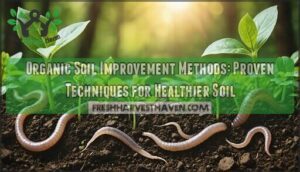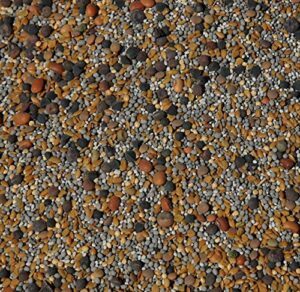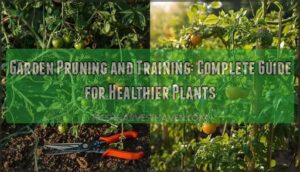This site is supported by our readers. We may earn a commission, at no cost to you, if you purchase through links.

Organic soil improvement methods offer a practical way to revive tired ground, boost crop yields, and protect the environment at the same time. Whether you’re working with dense clay or sandy patches, understanding these techniques can transform your soil into a thriving foundation for whatever you want to grow.
Table Of Contents
- Key Takeaways
- Why Organic Soil Improvement Matters
- Assessing Your Soil Before Improvement
- Top Organic Amendments for Better Soil
- Biological Practices for Healthy Soil
- Sustainable Techniques for Ongoing Soil Health
- Frequently Asked Questions (FAQs)
- What are 3 methods of improving soil organic matter?
- What are the five methods of soil improvement?
- How can I make my soil more organic?
- How do you turn bad soil into good soil naturally?
- What are the methods of improving soil?
- How long does organic certification transition take?
- What soil testing frequency is recommended annually?
- Which organic amendments work best for clay?
- How does seasonal timing affect cover crops?
- What equipment is needed for conservation tillage?
- Conclusion
Key Takeaways
- Organic soil improvement methods like composting, cover crops, and beneficial microbes boost soil health, crop yields, and environmental resilience.
- Testing and understanding your soil type, drainage, and nutrient needs is essential before making improvements for long-term garden success.
- Biological practices such as no-till gardening, crop rotation, and fostering soil organisms create a thriving, self-healing foundation for plants.
- Regular use of organic amendments and sustainable techniques keeps soils fertile, supports biodiversity, and ensures healthier food for you and your community.
Why Organic Soil Improvement Matters
Healthy soil is the foundation of any thriving garden or farm. Choosing organic methods can benefit your land, your crops, and the environment.
Here’s what matters most when you’re looking to improve your soil organically.
Importance of Soil Health
Healthy soil is the quiet foundation beneath your feet, shaping the vitality of every plant and harvest you hope to grow. When you nurture soil biodiversity and organic matter, you activate nutrient cycling, water retention, and carbon sequestration.
Healthy soil quietly shapes every harvest, powering plant vitality through biodiversity, nutrient cycling, and water retention
Strong soil structure boosts plant resilience, improves soil fertility, and ensures nutient availability—making healthy soil your most reliable ally in any garden or field.
Environmental Benefits of Organic Methods
When you choose organic methods, you’re investing in more than just your soil. You’re helping:
- Boost carbon sequestration for climate stability
- Improve water quality by reducing runoff
- Cut greenhouse gas emissions from fertilizer use
- Foster soil biodiversity and beneficial soil organisms
- Strengthen ecosystem resilience for sustainable agriculture
Organic practices also contribute to lower global warming. That’s how soil health ripples out, shaping a healthier environment for everyone.
Health Impacts of Improved Soil
As your soil grows richer and more alive, those benefits ripple straight into your food, your health, and the wellbeing of everyone who eats from your garden. Nutrient density in crops improves, boosting human health and disease resistance.
Active beneficial soil organisms and microbial activity support plant health, while a thriving gut microbiome starts with nutrient availability and high crop quality.
Assessing Your Soil Before Improvement
Before you start improving your soil, it helps to know what you’re working with. A few simple checks can reveal a lot about its health and structure.
Here’s how you can get a clear picture before making any changes.
Do You Need a Soil Test?
Ever wondered if skipping a soil test is worth the risk? You stand to miss out on three big wins:
- Economic benefits—fertilizer savings add up fast.
- Catching nutrient deficiencies before they stunt growth.
- Making smart agronomic decisions that protect your soil and the environment.
Testing frequency matters; it shapes every soil amendment and nutrient move you make. Farmers can also realize substantial savings by understanding residual nitrogen levels.
Soil Tests You Can Do at Home
Curious how you can get a clearer picture of your soil’s health without fancy lab equipment? Try these DIY soil testing methods—each reveals something unique. Whether you’re checking soil pH or counting worms, these tests guide your soil amendment choices and help spot nutrient deficiencies early.
| Test Type | What It Reveals |
|---|---|
| DIY pH Testing | Soil acidity/alkalinity |
| Soil Texture Analysis | Sand, silt, clay balance |
| Drainage Jar Test | Water movement |
| Nutrient Deficiency ID | Missing nutrients |
| Worm Count Analysis | Soil biological activity |
How to Test Soil Drainage Before Planting
Wondering if your garden beds will soak up rain or leave your roots swimming? Try these drainage test methods before planting:
- Dig a hole and fill it with water—watch how fast it drains.
- Check for puddles after a storm.
- Feel soil texture for compaction.
- Note any musty smells—poor aeration signals trouble.
Interpreting drainage results helps you target amending drainage issues for ideal levels.
Understanding Soil Types: Silty Vs. Clay Soils
When you dig into your garden, how do you tell if what’s beneath your shovel is silky-smooth silt or stubborn, sticky clay? Silty soils feel soft, drain well, and offer easy workability. Clay soils, with their dense structure, hold nutrients but resist water movement, leading to poor aeration.
Knowing these soil types and characteristics guides your organic improvement choices.
Top Organic Amendments for Better Soil
Healthy soil doesn’t happen by accident—it starts with what you put into it. The right amendments can turn lackluster dirt into a thriving home for your plants.
Let’s look at some proven organic options that make a real difference.
Using Compost to Enhance Structure
Think of compost as the secret ingredient that turns tired, compacted soil into a loose, crumbly bed where roots can thrive. By adding organic materials with varied compost particle size, you improve garden soil aeration porosity, boost water retention, and cut down on compaction—all essential for root penetration and healthy plant growth.
Here’s how compost helps:
- Increases aeration and drainage.
- Improves soil structure for better root movement.
- Boosts water retention, reducing the need to irrigate.
- Decreases compaction, making soil easier to work.
Green Manures and Cover Crops
Ever noticed how letting a patch of clover or rye grow can turn a bare garden bed into nature’s own green shield for your soil? These cover crops act as green manure, fixing nitrogen in soil, stopping erosion, and suppressing weeds.
By improving soil structure and boosting biodiversity impact, green manures offer an essential, sustainable tool for organic soil management.
Biofertilizers and Beneficial Microorganisms
Microbial inoculants, like arbuscular mycorrhizal fungi and beneficial microbes, play key roles in nitrogen fixation and building soil biomes. Compost tea introduces a diverse cast of soil microorganisms, weaving mycorrhizal networks that help plants access nutrients.
These beneficial soil microorganisms boost fertility and resilience, making your soil more productive—much like a city thriving on cooperation and diversity.
No Till 13 Seed Cover Crop

This diverse cover crop blend uses carefully chosen seed mix ratios to tackle weed suppression, soil compaction, and water retention. By layering root systems and leaf canopies, you’ll encourage nutrient cycling while protecting delicate soil structure.
No till gardening practices let you improve soil health year-round—making cover crops a cornerstone of organic gardening methods that build lasting fertility.
Biological Practices for Healthy Soil
For building healthy soil, biological practices play a key role. These methods work with nature to boost soil life and support long-term fertility.
Here are some proven approaches you can use.
Mycorrhizal Fungi and Plant Health
Roots and relationships—mycorrhizal fungi form a living bridge between plant roots and the soil, driving Nutrient Uptake and Growth Enhancement. Through Fungal Symbiosis, these beneficial microbes boost Disease Resistance and Yield Improvement.
AMF colonization weaves organic matter and soil organisms together, strengthening soil health and supporting plants in ways chemical inputs simply can’t replicate.
Bacterial Inoculants for Nitrogen Fixation
Just as mycorrhizal fungi strengthen nutrient uptake, bacterial inoculants for nitrogen fixation boost Nitrogen Availability by working with beneficial microbes.
Inoculant Effectiveness hinges on Application Methods and soil conditions—too much disturbance or poor matching can backfire.
Weigh Environmental Impacts and Cost Analysis before use; successful nitrogen fixation in soil fosters healthy soil organisms and lasting productivity.
Conservation Tillage and Reduced Disturbance
By choosing no-till gardening or reducing tillage, you protect soil organic matter and boost soil health. These agricultural practices help with erosion reduction, improve water retention, and keep soil compaction in check.
You’ll also see a positive biodiversity impact and support carbon sequestration. Think of it as giving your soil a chance to breathe and build resilience naturally.
Crop Rotation for Soil Fertility
Rotating your crops from season to season is like giving your soil a fresh start, letting each plant type restore nutrients and break up pest cycles naturally. Here’s how crop rotation benefits your soil:
- Boosts nitrogen fixation with legumes.
- Improves soil structure by varying root systems.
- Improves pest management through strategic planting sequence.
Organic methods weave resilience into agricultural practices.
Sustainable Techniques for Ongoing Soil Health
Keeping your soil healthy isn’t a one-time effort—it’s about using smart, sustainable practices year after year. There are proven techniques that make a real difference, both for your plants and the environment.
Here’s what you can do to support ongoing soil health.
Mulching for Moisture and Weed Control
Mulch types vary, but each works to regulate soil temperature and lock in soil moisture. As organic matter breaks down, it improves soil structure and aids moisture retention. You’ll notice fewer weeds thanks to effective weed suppression, and decomposition rates help cycle nutrients back into your soil.
For weed control and healthier soil, choose mulch that suits your garden’s unique needs.
Integrated Pest Management
Ever wondered how organics keep pests in check without sacrificing soil health? Integrated Pest Management (IPM) weaves together biological controls, targeted pesticide reduction, and sustainable solutions.
You’ll see IPM benefits in healthier soil, improved nutrients, and resilient microorganisms.
The economic impact is real, too—farmers report higher yields and lower costs, all while boosting soil fertility for the long haul.
Documenting Soil Practices for Certification
If you want your organic efforts to count where it matters, keeping clear records of your soil practices is the key that unlocks certification. Reliable record keeping—tracking soil organic matter, field applications, and soil tests—creates the audit trail for compliance standards.
When inspection time rolls around, having neat documentation and proof of regulatory adherence shows you’re serious about improving soil health with proven organic farming practices.
Balancing Carbon and Nitrogen in Soil
Getting the right mix of carbon and nitrogen in your soil is a bit like tuning an engine—too much of one or the other, and things just don’t run as smoothly as they should.
For balanced C:N Ratio and healthy decomposition rates, focus on:
- Green Manures
- Diverse carbon sources
- Active nutrient cycling
- Encouraging soil microbes for carbon sequestration
Frequently Asked Questions (FAQs)
What are 3 methods of improving soil organic matter?
Composting methods build organic matter and boost soil carbon—think food scraps turned into rich compost. Cover cropping shields soil from erosion, adding organic matter.
Manure application or biofertilizer types improve soil health by enriching soil amendments naturally.
What are the five methods of soil improvement?
Imagine your soil as a living quilt—five ways to stitch it stronger are composting methods, using cover crops, applying biofertilizer types, practicing gentle tillage, and embracing mulching benefits for improving soil health and organic matter.
How can I make my soil more organic?
You can make your soil more organic by applying compost, practicing cover cropping, using biofertilizers, adjusting tillage practices, and adding mulch.
These soil amendment techniques improve garden soils by incorporating organic matter and boosting overall soil quality.
How do you turn bad soil into good soil naturally?
You can turn poor soil into productive ground by incorporating organic matter, using Natural Amendments like compost, practicing Cover Cropping, and focusing on Soil Microbes.
These soil amendment techniques boost aeration, drainage, and erosion control, improving garden soils.
What are the methods of improving soil?
Ever wondered how to boost your soil’s health? Composting techniques, manure utilization, soil aeration, green manuring, and mineral amendments all help by improving soil quality, enhancing nutrient content, and supporting better soil drainage and structure.
How long does organic certification transition take?
The conversion timeline for organic certification usually spans three years. During this period, you’ll use approved organic farming methods, gather documentation needed, prepare for inspection readiness, and factor in cost elements tied to improving soil health and management.
What soil testing frequency is recommended annually?
Soil testing frequency should line up with crop needs and seasonal changes—most organic growers test annually to track nutrient variability and pH.
Routine soil tests and analysis, interpreted with historical data, guide targeted amendments for healthier yields.
Which organic amendments work best for clay?
For clay soil, adding organic amendments like compost and well-rotted manure improves drainage, reduces compaction, and boosts nutrient availability.
These clay amendment options offer long-term benefits, making your soil easier to work and healthier for plants.
How does seasonal timing affect cover crops?
Seasonal timing shapes cover crops’ success, from crop selection to frost impact. Planting green manure cover crops before winter boosts weed suppression, nutrient cycling, and soil organic matter.
Soil temperature influences growth and overall improvement in soil health.
What equipment is needed for conservation tillage?
Picture a field where heavy plows are swapped for No-Till Drills, Planter Attachments, and Residue Management Tools.
These Tillage Equipment Types, alongside regular Equipment Maintenance, help preserve soil health—think of them as your essential Soil Health Tool kit.
Conclusion
One teaspoon of healthy soil can contain more microorganisms than there are humans on the planet—a microscopic world that powers your entire garden. When you embrace organic soil improvement methods, you’re not just reshaping the earth underfoot; you’re building a living system that repairs itself over time.
Your choices—composting, cover crops, or biological inoculants—set that system in motion. Good soil remembers every ounce of care, returning the favor with healthy plants, richer harvests, and greater resilience.
- https://www.farmstandapp.com/20189/organic-soil-amendment-options/
- https://hgic.clemson.edu/4-ways-to-improve-your-gardens-soil-health-no-tillage-methods/
- https://extension.oregonstate.edu/news/add-organic-matter-improve-garden-soils
- https://extension.umd.edu/resource/soil-health-drainage-and-improving-soil
- http://organicfarmersassociation.org/new-farm/



